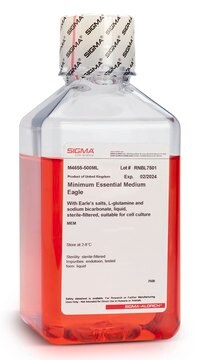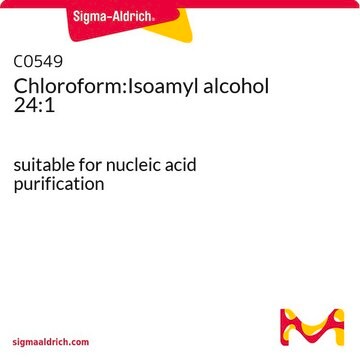If this product has an expiration or retest date, it will be shown on the Certificate of Analysis (COA, CofA). If there is no retest or expiration date listed on the product's COA, we do not have suitable stability data to determine a shelf life. For these products, the only date on the COA will be the release date; a retest, expiration, or use-by-date will not be displayed.
For all products, we recommend handling per defined conditions as printed in our product literature and website product descriptions. We recommend that products should be routinely inspected by customers to ensure they perform as expected.
For products without retest or expiration dates, our standard warranty of 1 year from the date of shipment is applicable.
For more information, please refer to the Product Dating Information document: https://www.sigmaaldrich.com/deepweb/assets/sigmaaldrich/marketing/global/documents/449/386/product-dating-information-mk.pdf
H6269
Bromure d'hexadécyltriméthylammonium
for molecular biology, ≥99%
Synonyme(s) :
Bromure de cétrimonium, Bromure de cétyltriméthylammonium, Bromure de palmityltriméthylammonium, CTAB
Sélectionner une taille de conditionnement
Sélectionner une taille de conditionnement
About This Item
Produits recommandés
Qualité
Molecular Biology
for molecular biology
Description
cationic
Essai
≥99%
Forme
powder or crystals
Poids mol.
micellar avg mol wt 62,000
Nombre d'agrégation
170
pH
5.0-7 (25 °C, 36.4 g/L)
CMC
0.92
1 mM (20-25°C)
Pf
248-251 °C (lit.)
Solubilité
H2O: 1/10 g/mL
HLB
10
Adéquation
suitable for DNA precipitation
Activité étrangère
DNAse (Detection)
NICKase Detection
RNAse, none detected
Chaîne SMILES
[Br-].CCCCCCCCCCCCCCCC[N+](C)(C)C
InChI
1S/C19H42N.BrH/c1-5-6-7-8-9-10-11-12-13-14-15-16-17-18-19-20(2,3)4;/h5-19H2,1-4H3;1H/q+1;/p-1
Clé InChI
LZZYPRNAOMGNLH-UHFFFAOYSA-M
Vous recherchez des produits similaires ? Visite Guide de comparaison des produits
Catégories apparentées
Application
Mention d'avertissement
Danger
Mentions de danger
Conseils de prudence
Classification des risques
Acute Tox. 4 Oral - Aquatic Acute 1 - Aquatic Chronic 1 - Eye Dam. 1 - Skin Irrit. 2 - STOT RE 2 Oral - STOT SE 3
Organes cibles
Gastrointestinal tract, Respiratory system
Code de la classe de stockage
11 - Combustible Solids
Classe de danger pour l'eau (WGK)
WGK 3
Point d'éclair (°F)
471.2 °F - closed cup
Point d'éclair (°C)
244 °C - closed cup
Équipement de protection individuelle
dust mask type N95 (US), Eyeshields, Faceshields, Gloves
Faites votre choix parmi les versions les plus récentes :
Déjà en possession de ce produit ?
Retrouvez la documentation relative aux produits que vous avez récemment achetés dans la Bibliothèque de documents.
Les clients ont également consulté
Articles
Single molecule electronics is the endeavour of constructing electronic circuitry with single molecules as the fundamental building block.
-
How can I determine the shelf life / expiration / retest date of this product?
1 answer-
Helpful?
-
-
How is shipping temperature determined? And how is it related to the product storage temperature?
1 answer-
Products may be shipped at a different temperature than the recommended long-term storage temperature. If the product quality is sensitive to short-term exposure to conditions other than the recommended long-term storage, it will be shipped on wet or dry-ice. If the product quality is NOT affected by short-term exposure to conditions other than the recommended long-term storage, it will be shipped at ambient temperature. As shipping routes are configured for minimum transit times, shipping at ambient temperature helps control shipping costs for our customers. For more information, please refer to the Storage and Transport Conditions document: https://www.sigmaaldrich.com/deepweb/assets/sigmaaldrich/marketing/global/documents/316/622/storage-transport-conditions-mk.pdf
Helpful?
-
-
수용액에 대한 용해도가 36.4g/Liter (100 mM)로 되어 있는데, 1% (29 mM) 수용액을 제작하여 Light Scattering으로 Particle를 측정 시 0.5 um 크기 이상의 particle이 5000 개 /mL이상 측정됩니다. CMC(0.9 mM) 보다 농도가 높아 Micelle이 형성되었나 하는 생각도 있지만, Micelle 대비 입자 크기가 커서 무엇인지 궁금합니다.
1 answer-
For Product H6269 (commonly known as CTAB), the micellar properties have been well studied. The formation of the micelles is dependent on the pH of the solution, as well as the presence of any additives. The CMC has been reported variously as either 0.9 mM or 1.0 mM, so at 29 mM a great majority of the CTAB should be in the form of micelles. The large particles being observed may be aggregates of micelles.
Running a control sample at a lower CTAB concentration (around 1 mM) would be recommended.
The micellar properties have been studied by both static light scattering and dynamic light scattering; see:
https://www.sciencedirect.com/science/article/pii/S0927775714003835#bib0030
The second paragraph of the Introduction section of that paper cites references 12, 4 and 5.Helpful?
-
Active Filters
Notre équipe de scientifiques dispose d'une expérience dans tous les secteurs de la recherche, notamment en sciences de la vie, science des matériaux, synthèse chimique, chromatographie, analyse et dans de nombreux autres domaines..
Contacter notre Service technique











